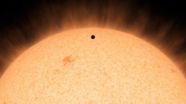(Press-News.org) Skygazers at northern latitudes are familiar with the W-shaped star pattern of Cassiopeia the Queen. This circumpolar constellation is visible year-round near the North Star. Tucked next to one leg of the W lies a modest 5th-magnitude star named HD 219134 that has been hiding a secret.
Astronomers have now teased out that secret: a planet in a 3-day orbit that transits, or crosses in front of its star. At a distance of just 21 light-years, it is by far the closest transiting planet to Earth, which makes it ideal for follow-up studies. Moreover, it is the nearest rocky planet confirmed outside our solar system. Its host star is visible to the unaided eye from dark skies, meaning anyone with a good star map can see this record-breaking system.
"Most of the known planets are hundreds of light-years away. This one is practically a next-door neighbor," said astronomer Lars A. Buchhave of the Harvard-Smithsonian Center for Astrophysics (CfA).
"Its proximity makes HD 219134 ideal for future studies. The James Webb Space Telescope and future large ground-based observatories are sure to point at it and examine it in detail," said lead author Ati Motalebi of the Geneva Observatory.
The newfound world, designated HD 219134b, was discovered using the HARPS-North instrument on the 3.6-meter Telescopio Nazionale Galileo in the Canary Islands. The CfA is a major partner with the Geneva Observatory on the HARPS-North Collaboration, which includes several other European partners.
HARPS-North detects planets using the radial velocity method, which allows astronomers to measure a planet's mass. HD 219134b weighs 4.5 times the mass of Earth, making it a super-Earth.
With such a close orbit, researchers realized that there was good possibility the planet would transit its star. In April of this year they targeted the system with NASA's Spitzer Space Telescope. At the appropriate time, the star dimmed slightly as the planet crossed the star's face. Measuring the depth of the transit gave the planet's size, which is 1.6 times Earth. As a result, the team can calculate the planet's density, which works out to about 6 g/cm3. This shows that HD 219134b is a rocky world.
But wait, there's more! The team detected three additional planets in the system using radial velocity data. A planet weighing at least 2.7 times Earth orbits the star once every 6.8 days. A Neptune-like planet with 9 times the mass of Earth circles in a 47-day orbit. And much further out, a hefty fourth world 62 times Earth's mass orbits at a distance of 2.1 astronomical units (200 million miles) with a "year" of 1,190 days. Any of these planets might also transit the star, so the team plans to search for additional transits in the months ahead.
HD 219134 is an orange Type K star somewhat cooler, smaller and less massive than our Sun. Its key measurements have been pinned down very precisely, which thus allows a more precise determination of the properties of its accompanying planets.
This discovery came from the HARPS-North Rocky Planet Search, a dedicated survey examining about 50 nearby stars for signs of small planets. The team targeted nearby stars because those stars are brighter, which makes follow-up studies easier. In particular, additional observations might allow the detection and analysis of planetary atmospheres.
HD 219134 was one of the closest stars in the sample, so it was particularly lucky to find that it hosts a transiting planet. This system now holds the record for the nearest transiting exoplanet. As such, it likely will be a favorite for researchers for years to come.
INFORMATION:
WASHINGTON, D.C. - Shifts in trade winds and ocean currents powered a resurgence of endangered Galápagos penguins over the past 30 years, according to a new study. These changes enlarged a cold pool of water the penguins rely on for food and breeding - an expansion that could continue as the climate changes over the coming decades, the study's authors said.
The Galápagos Islands, a chain of islands 1,000 kilometers (600 miles) west of mainland Ecuador, are home to the only penguins in the Northern Hemisphere. The 48-centimeter (19-inch) tall black and white ...
PROVIDENCE, R.I. [Brown University] -- Even after centuries of earnest oaths and laws, the debate about whether money compromises medicine remains unresolved, observes Dr. Eli Adashi in a new paper in the AMA Journal of Ethics. The problem might not be truly intractable, he said, but recent reforms will likely make little progress or difference.
"This is one of those things we have to appreciate as being with us for a long time," said Adashi, former dean of medicine and biological sciences at Brown University. "It will probably be with us forever. It's probably not entirely ...
Soldiers who served in the glaring desert sunlight of Iraq and Afghanistan returned home with an increased risk of skin cancer, due not only to the desert climate, but also a lack of sun protection, Vanderbilt dermatologist Jennifer Powers, M.D., reports in a study published recently in the Journal of Investigative Dermatology.
"The past decade of United States combat missions, including operations in Iraq and Afghanistan, have occurred at a more equatorial latitude than the mean center of the United States population, increasing the potential for ultraviolet irradiance ...
PHILADELPHIA - Researchers at the Perelman School of Medicine at the University of Pennsylvania have devised an entirely new approach to vaccines - creating immunity without vaccination.
The study, published in Scientific Reports, demonstrated that animals injected with synthetic DNA engineered to encode a specific neutralizing antibody against the dengue virus were capable of producing the exact antibodies necessary to protect against disease, without the need for standard antigen-based vaccination. Importantly, this approach, termed DMAb, was rapid, protecting animals ...
With Congress currently debating the repeal of mandatory country-of-origin labeling (COOL) for meat and poultry - federal law in the US since 2002 - new research from the Sam W. Walton College of Business at the University of Arkansas shines a spotlight on how COOL labeling affects consumers' purchase decisions.
In "A COOL Effect: The Direct and Indirect Impact of Country-of-Origin Disclosures on Purchase Intentions for Retail Food Products," appearing in the September issue of the Journal of Retailing, Marketing Professors Elizabeth Howlett and Scot Burton, along with ...
Researches from the Laboratory of Nanooptics and Plasmonics at the MIPT Center of Nanoscale Optoelectronics have developed a new method for optical communication on a chip, which will give a possibility to decrease the size of optical and optoelectronic elements and increase the computer performance several tenfold. According to their article published in Optics Express, they have proposed the way to completely eliminate energy losses of surface plasmons in optical devices.
"Surface plasmon polaritons have previously been proposed to be used as information carriers for ...
WASHINGTON, Aug. 3, 2015 -- Strawberries are sweet, juicy and delightful. Unfortunately, an expiring federal pesticide exemption could mean 2016 will be the end of strawberries in the U.S. How can we protect our strawberries from pests and comply with federal fumigant standards? In this Speaking of Chemistry video, Sophia Cai explains the problem and some possible solutions. Check it out here: https://youtu.be/noaec9-BmwU.
Speaking of Chemistry is a production of Chemical & Engineering News, a weekly magazine of the American Chemical Society. The program features fascinating, ...
(WASHINGTON, August 3, 2015) - The first protein engineered to help control bleeding episodes in patients with severe von Willebrand disease (vW disease) has been shown to be safe and effective, according to results of a Phase III trial. Study data were published online today in Blood, the Journal of the American Society of Hematology
When a blood vessel becomes damaged, a protein called von Willebrand factor (vWF) helps stop bleeding by guiding clot-forming platelets to the injury. vWF serves as the "glue" that helps platelets stick to a wound. Approximately 1 percent ...
Researchers at Northwestern University are using a novel dimensional method for distinguishing misbehavior that is expectable in early childhood versus that which is cause for clinical concern. Their study is published in the August 2015 issue of the Journal of the American Academy of Child and Adolescent Psychiatry.
Using a survey developed by the researchers to enhance precision of clinical identification in early childhood the Multidimensional Assessment Profile of Disruptive Behavior (MAP-DB), scientists obtained mothers' reports of their preschoolers' irritability ...
The World Glacier Monitoring Service, domiciled at the University of Zurich, has compiled worldwide data on glacier changes for more than 120 years. Together with its National Correspondents in more than 30 countries, the international service just published a new comprehensive analysis of global glacier changes in the Journal of Glaciology. In this study, observations of the first decade of the 21st century (2001-2010) were compared to all available earlier data from in-situ, air-borne, and satellite-borne observations as well as to reconstructions from pictorial and written ...



